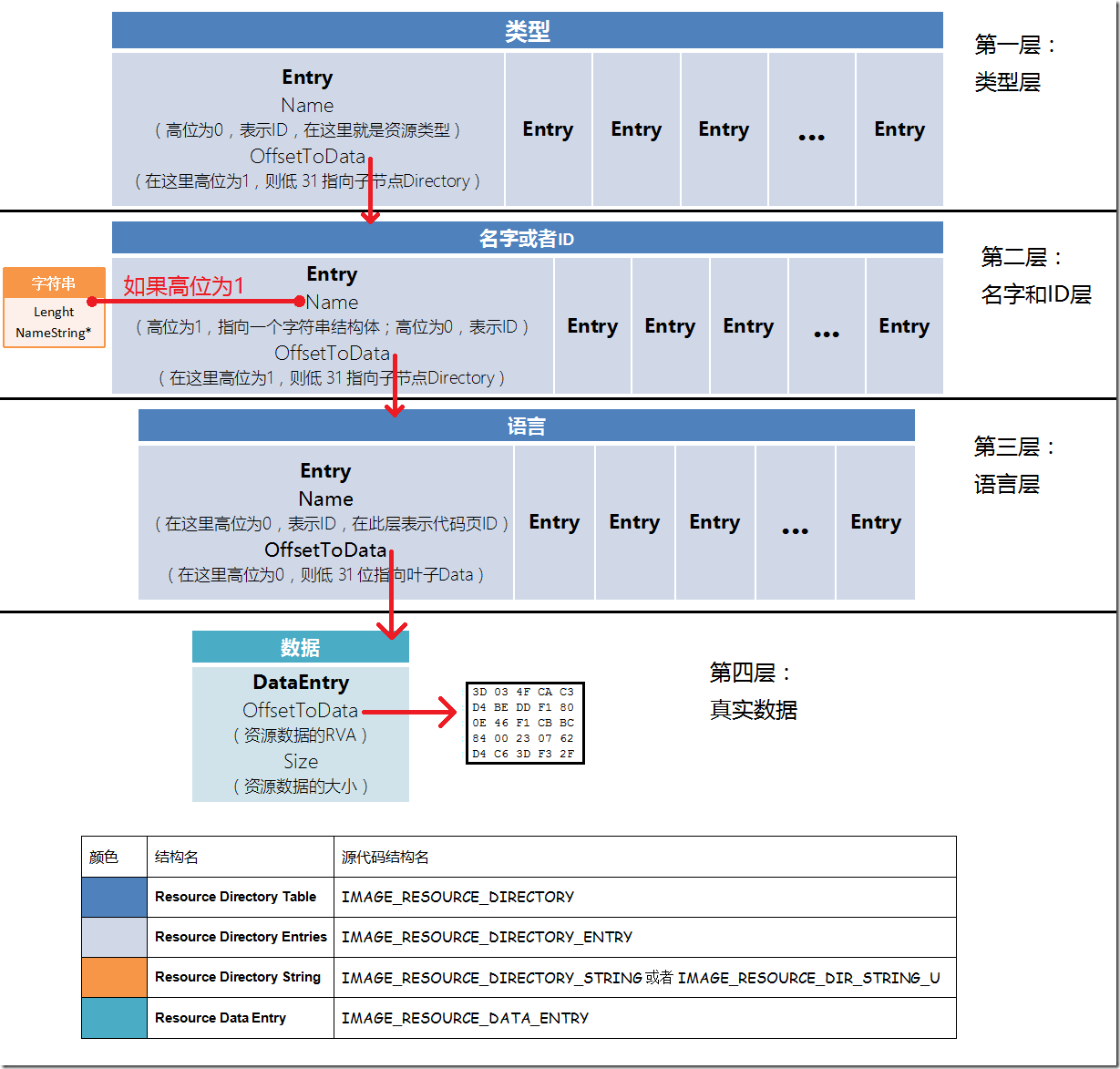[PE结构分析] 11.资源表结构
资源表是一个树形结构,可以设置成2的31次方的层数,Windows 使用了3级:
类型->名称->语言
其中涉及到四个结构:
| Data | Description |
| Resource Directory Tables (and Resource Directory Entries) | A series of tables, one for each group of nodes in the tree. All top-level (Type) nodes are listed in the first table. Entries in this table point to second-level tables. Each second-level tree has the same Type ID but different Name IDs. Third-level trees have the same Type and Name IDs but different Language IDs. Each individual table is immediately followed by directory entries, in which each entry has a name or numeric identifier and a pointer to a data description or a table at the next lower level. |
| Resource Directory Strings | Two-byte-aligned Unicode strings, which serve as string data that is pointed to by directory entries. |
| Resource Data Description | An array of records, pointed to by tables, that describe the actual size and location of the resource data. These records are the leaves in the resource-description tree. |
| Resource Data | Raw data of the resource section. The size and location information in the Resource Data Descriptions field delimit the individual regions of resource data. |
Resource Directory Table
Each resource directory table has the following format. This data structure should be considered the heading of a table because the table actually consists of directory entries (described in section 6.9.2, "Resource Directory Entries") and this structure:
| Offset | Size | Field | Description |
| 0 | 4 | Characteristics | Resource flags. This field is reserved for future use. It is currently set to zero. |
| 4 | 4 | Time/Date Stamp | The time that the resource data was created by the resource compiler. |
| 8 | 2 | Major Version | The major version number, set by the user. |
| 10 | 2 | Minor Version | The minor version number, set by the user. |
| 12 | 2 | Number of Name Entries | The number of directory entries immediately following the table that use strings to identify Type, Name, or Language entries (depending on the level of the table). |
| 14 | 2 | Number of ID Entries | The number of directory entries immediately following the Name entries that use numeric IDs for Type, Name, or Language entries. |
Resource Directory Entries
The directory entries make up the rows of a table. Each resource directory entry has the following format. Whether the entry is a Name or ID entry is indicated by the resource directory table, which indicates how many Name and ID entries follow it (remember that all the Name entries precede all the ID entries for the table). All entries for the table are sorted in ascending order: the Name entries by case-sensitive string and the ID entries by numeric value. Offsets are relative to the address in the IMAGE_DIRECTORY_ENTRY_RESOURCE DataDirectory.
| Offset | Size | Field | Description |
| 0 | 4 | Name Offset | The offset of a string that gives the Type, Name, or Language ID entry, depending on level of table. |
| 0 | 4 | Integer ID | A 32-bit integer that identifies the Type, Name, or Language ID entry. |
| 4 | 4 | Data Entry Offset | High bit 0. Address of a Resource Data entry (a leaf). |
| 4 | 4 | Subdirectory Offset | High bit 1. The lower 31 bits are the address of another resource directory table (the next level down). |
Resource Directory String
The resource directory string area consists of Unicode strings, which are word-aligned. These strings are stored together after the last Resource Directory entry and before the first Resource Data entry. This minimizes the impact of these variable-length strings on the alignment of the fixed-size directory entries. Each resource directory string has the following format:
| Offset | Size | Field | Description |
| 0 | 2 | Length | The size of the string, not including length field itself. |
| 2 | variable | Unicode String | The variable-length Unicode string data, word-aligned. |
Resource Data Entry
Each Resource Data entry describes an actual unit of raw data in the Resource Data area. A Resource Data entry has the following format:
| Offset | Size | Field | Description |
| 0 | 4 | Data RVA | The address of a unit of resource data in the Resource Data area. |
| 4 | 4 | Size | The size, in bytes, of the resource data that is pointed to by the Data RVA field. |
| 8 | 4 | Codepage | The code page that is used to decode code point values within the resource data. Typically, the code page would be the Unicode code page. |
| 12 | 4 | Reserved, must be 0. | |
本文作者:endlesstravel
本文链接:https://www.cnblogs.com/night-ride-depart/p/5783157.html
版权声明:本作品采用知识共享署名-非商业性使用-禁止演绎 2.5 中国大陆许可协议进行许可。





【推荐】国内首个AI IDE,深度理解中文开发场景,立即下载体验Trae
【推荐】编程新体验,更懂你的AI,立即体验豆包MarsCode编程助手
【推荐】抖音旗下AI助手豆包,你的智能百科全书,全免费不限次数
【推荐】轻量又高性能的 SSH 工具 IShell:AI 加持,快人一步